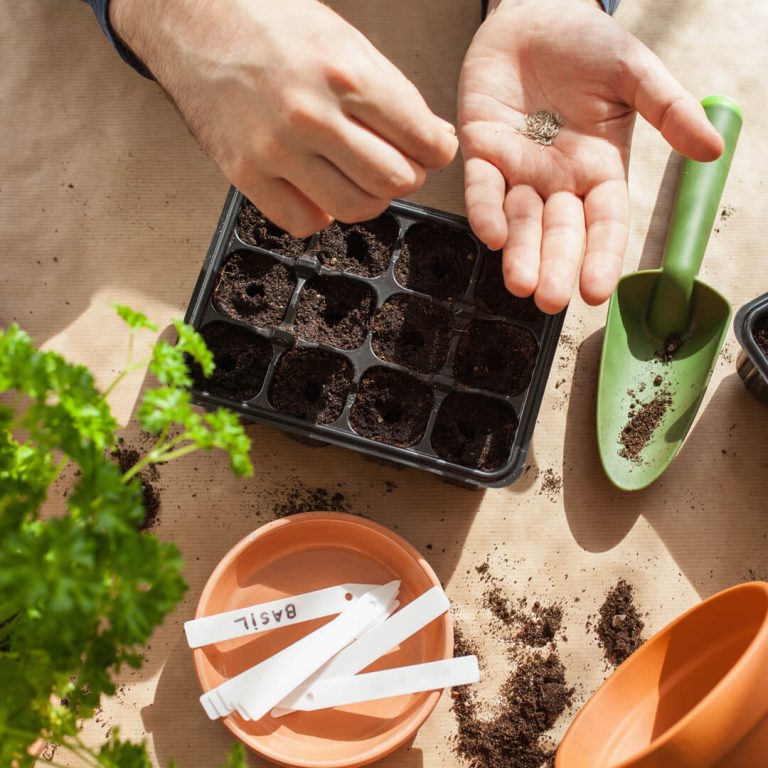U.S. households spent an average of $6,053 annually on food consumed at home in 2023—about 15% higher than what was spent in 2021. These rising prices are leading families to look for creative ways to cut corners.
According to an article published by The University of Missouri, households with a food garden spend an average of $70 per year on seeds and other supplies, but the gardens produce about $600 worth of food (a not-too-shabby return on investment!). Given these impressive savings, growing your own vegetable and herb garden can be a cost-effective strategy worth considering.
Below are tips to get started growing a garden, no matter how much land you have (or don’t have).
1. It’s not too late to start.
Contrary to popular belief, spring isn’t too late to start a garden. In fact, some vegetables, like beans, peas, spinach, kale and squash, can be grown from seeds starting as late as July. The later the first frost of the season is where you live, the later you can begin planting. If you grow your garden from baby plants (also called transplants or starts) instead of seeds, you can begin the process even later. Consider staggering your planting so you have vegetables ready to eat as far into the later months of the year as possible.
2. Keep it simple.
New gardeners may want to start simple, selecting just three or four types of manageable plants. The Old Farmer’s Almanac, which contains a wealth of information for both beginning and experienced gardeners including online planners to map out your garden, suggests the following vegetables are easy to grow and suitable for beginners:
- Tomatoes
- Peppers
- Bush beans
- Cabbage
- Carrots
- Chard
- Lettuce
- Radishes
- Zucchini squash
Are you looking for a short growing season? Radishes are ready to eat in just about 30 days. Do you want something that needs little tending? Peppers are a good choice. As you talk to experts or read up on various options, decide what you think will work best for you based on your skill level and how much time and energy you have to devote to your garden.
According to the U.S. Department of Agriculture, potatoes, tomatoes, and carrots are among the most commonly-consumed vegetables. Here is how much money you can save by growing these vegetables at home:
- Potatoes: A 10-ft. row of potato seed pieces—which costs about $7 to plant—can produce between six and 15 lbs of potatoes per season. With potatoes averaging $0.86 per pound, that row of potatoes could produce up to $12.90 worth of potatoes per season.
- Tomatoes: You can purchase a small tomato plant for about $5. A single tomato plant can produce 10 to 15 lbs of fruit per season. At the grocery store, you can expect to pay $1.80 per pound, so 10 lbs of tomatoes would cost $18. By growing them yourself, you could save $13 each season.
- Carrots: Carrots are one of the least expensive vegetables to grow at home. A pack of 100 seeds is usually about $3, and a single pack of seeds can generate 16 lbs of carrots. The cost of carrots is usually about $1.80 per pound at the grocery store, so that seed packet would be worth about $28.80 in produce—a significant return on investment.
Combined, you would spend $15 on seeds or small plants. At the end of the season, you’d harvest about $60 worth of produce. Even with a small garden, that’s a substantial result!
3. Get creative.
You don’t need a big yard to start a garden. In fact, you don’t need a yard at all. You can grow vegetables and herbs in containers on a small balcony or patio or even in a window box. Or, you can invest in a small, indoor hydroponics garden for your countertop, which allows you to grow herbs without any outdoor access.
Think about the space you have. If you don’t have a yard, what types of vegetables and herbs will grow in your environment? Many greens like cabbage, romaine lettuce, scallions and bok choy can be grown from cuttings or scraps, as can herbs like mint and basil.
Plus, you can save money by re-using some household items, such as old coffee cans or buckets, as planters. Just make sure the containers have ample space for the plants to grow (research how much the roots are expected to grow), and that there are proper drainage holes for the water in the bottom so that your plants don’t become overwatered.
If your area doesn’t get a ton of light, focus on herbs and vegetables that don’t need a lot of light to grow. Arugula, mustard greens, beets, broccoli, and carrots do well with less light. For herbs, basil, chives, mint and parsley are also suitable. Just be aware that a good majority of vegetables need sunlight for at least five hours a day.
4. Reduce the cost of supplies.
You don’t need to spend a lot of money on supplies, especially if you have a small space. Besides the containers, you just need soil, fertilizer, and a watering device. For larger spaces, tools like a trowel, pruning shears, and plant supports (if you have climbing plants) are a good investment. If you’re planting a garden in your yard, a rake and shovel will also help you get the job done, as could a wheelbarrow.
Before purchasing anything new, check with neighborhood “buy nothing” groups or local gardening clubs. You may find that local residents have unused tools they’re willing to give away or loan out, or you may find people willing to swap seeds.
Is a home garden worth the upfront cost?
Gardening can indeed be a cost-effective way to reduce your grocery bills and enjoy fresh produce right from your backyard. However, it’s important to approach it with realistic expectations. While growing your own vegetables and herbs can save money, the initial investment in tools, soil, fertilizer, and other supplies can add up quickly (one study we found even highlighted that the costs associated with gardening, such as purchasing equipment and maintaining the garden, can sometimes outweigh the savings on groceries). Therefore, it’s crucial to view gardening not just as a money-saving endeavor but as a hobby that brings joy and satisfaction.
If you enjoy the process of planting, nurturing, and harvesting your own food, the non-monetary benefits like physical exercise, mental well-being, and the pleasure of eating home-grown produce can make the investment worthwhile. Ultimately, the key is to balance the costs and benefits, and to ensure that gardening is an activity you genuinely enjoy.
Happy planting!






Comments Section
Please note: Comments are not monitored for member servicing inquiries and will not be published. If you have a question or comment about a Quorum product or account, please visit quorumfcu.org to submit a query with our Member Service Team. Thank you.